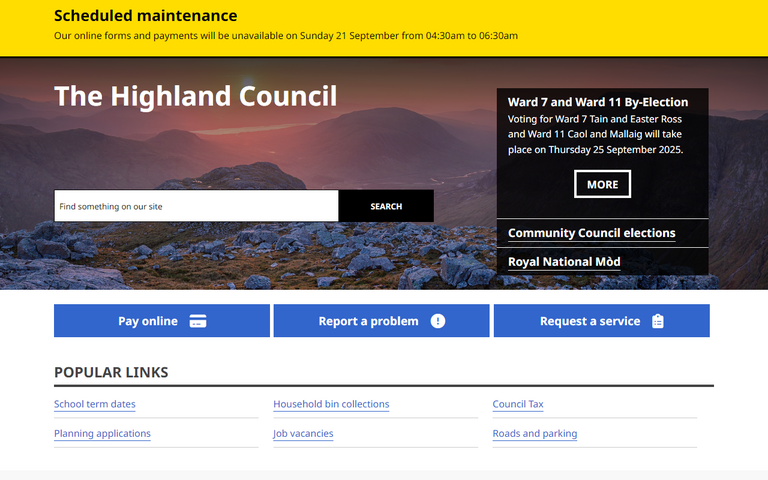Highland
§ This page gives an overview of the Highland local authority district, bringing together key facts, maps, and data to help you quickly understand the area. One of 361 district profiles on Baseview.
Overview ⁞ Highland is Scotland’s largest council area by land, covering vast mountain ranges, lochs, and coastal landscapes. Tourism, renewable energy, and agriculture dominate the economy. Inverness is the main city and a gateway to the Highlands.
Highland Boundary Map
This map shows the official boundary of the Highland local authority district, based on the latest geographic data published by the Office for National Statistics (ONS). It provides a clear view of the district’s extent and helps you understand how the area fits within the wider regional and national landscape.
Contains OS data © Crown copyright and database right 2025. Source: Office for National Statistics licensed under the Open Government Licence v3.0.
The administrative boundary of Highland can also be viewed on OpenStreetMap: District Boundary of Highland.
Key Facts about Highland
What region is Highland in? Highland is in Scotland, a statistical region and also a country in United Kingdom.
Is Highland a city? Yes, Highland is a city. Highland holds official city status as one of the 76 designated cities in the UK.
Who governs Highland? The local government for this district is: The Highland Council (Scotland Council Area).
▶ Official website of The Highland Council 🔗 highland.gov.uk

Which police force covers Highland? Policing in Highland is provided by Police Scotland 🔗 scotland.police.uk, which covers the whole of Scotland.
Highland in International Geographies
In the International Territorial Levels (ITLs) hierarchy, Highland is within an ITLs Level 3 area:
- (ITL 1) Scotland
- (ITL 2) ⇒ Highlands and Islands
- (ITL 3) ⇒⇒ Highlands and Islands
The International Territorial Levels are used by OECD member countries for statistical purposes to classify administrative areas. We have this listable page for easy browsing of ITL names and codes: International Territorial Levels.
Constituencies in Highland
Highland is divided into 4 parliamentary constituencies, listed below in alphabetical order.
- Argyll, Bute and South Lochaber
- Caithness, Sutherland and Easter Ross
- Inverness, Skye and West Ross-shire
- Moray West, Nairn and Strathspey
A constituency is a specific geographical area that elects one Member of Parliament (MP) to represent them in the House of Commons. The United Kingdom is divided into 650 parliamentary constituencies, 57 of them are in Scotland. We have this list page for easy browsing of all UK parliamentary constituencies: List of Constituencies.
Wards in Highland
Highland is divided into 21 wards, listed below in alphabetical order.
- Aird and Loch Ness
- Badenoch and Strathspey
- Black Isle
- Caol and Mallaig
- Cromarty Firth
- Culloden and Ardersier
- Dingwall and Seaforth
- East Sutherland and Edderton
- Eilean á Chèo
- Fort William and Ardnamurchan
- Inverness Central
- Inverness Millburn
- Inverness Ness-side
- Inverness South
- Inverness West
- Nairn and Cawdor
- North, West and Central Sutherland
- Tain and Easter Ross
- Thurso and Northwest Caithness
- Wester Ross, Strathpeffer and Lochalsh
- Wick and East Caithness
In the UK, a ward is a subdivision of a local authority area, used mainly for electoral and statistical purposes. Defined by the ONS, wards represent the primary unit for local elections, each returning one or more councillors to the local council. Wards are also used as a key geography for presenting population and census data.
Built-up Areas in Highland
Highland covers 85 built-up areas, listed below in alphabetical order.
- Achduchil
- Alness
- Ardersier
- Arisaig
- Auldearn
- Aultbea
- Aviemore
- Avoch
- Balintore
- Ballachulish
- Beauly
- Boat of Garten
- Bonar Bridge
- Breakish
- Broadford
- Brora
- Buldoo
- Cannich
- Caol
- Carrbridge
- Castletown
- Conon Bridge
- Contin
- Corpach
- Cradlehall
- Cromarty
- Croy (Highland)
- Culbokie
- Dingwall
- Dornoch
- Drumnadrochit
- Dunnet
- Duror
- East Helmsdale
- Embo
- Evanton
- Fendom
- Fort Augustus
- Fort William
- Fortrose
- Gairloch
- Glencoe
- Glenfinnan
- Golspie
- Grantown-on-Spey
- Halkirk
- Hardmuir
- Invergordon
- Inverness
- Isleornsay
- Kiltarlity
- Kincraig
- Kingussie
- Kinlochmore
- Kirkhill
- Kyle of Lochalsh
- Lairg
- Lochcarron
- Lochyside
- Lower Breakish
- Mallaig
- Maryburgh
- Muir of Ord
- Munlochy
- Nairn
- Nethy Bridge
- Newlands of Culloden
- Newtonmore
- Nigg Ferry
- North Ballachulish
- North Kessock
- Portmahomack
- Portree
- Portskerra
- Rosemarkie
- Roybridge
- Scrabster
- Spean Bridge
- Strathpeffer
- Strontian
- Tain
- Thurso
- Ullapool
- Watten
- Wick (Highland)
In the UK, a Built-up Area (BUA) is a continuous urban area of at least 20 hectares (0.2 km²), defined by the ONS as land where buildings are generally no more than 200 metres apart, such as towns, cities, or large villages. (Note: A BUA name marked with an asterisk (*) indicates that the area is situated partly in the district of Highland.)